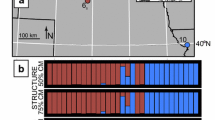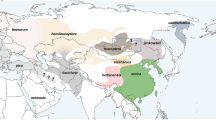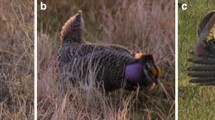Summary
A partial reproductive barrier found between subspecies of the California vole indicates that there may be obstacles to free interbreeding within this species in nature. Both the reduced fertility between subspecies and the sterility of hybrid males found in laboratory crosses would be obstacles to gene exchange between contiguous subspecies populations. Combative behavior engaged in by approximately half of the mixed subspecies pairs in the laboratory indicate that there might also be behavioral constraints to their breeding. Substantial differentiation has already occurred between M.c. californicus and stephensi in some of the faster evolving structural gene loci coding for enzymes not involved in glucose metabolism. Due to significant differences in body size, skull characteristics, and organ weights, the two subspecies are clearly distinguishable on the basis of these morphophysiological characters at this stage of reproductive isolation. Thus, there is good reason to believe that these populations of the California vole are diverging to the species level. I am continuing the investigation of the intraspecific divergence with a comparative study of the geographically intervening subspecies M.c. sanctidiegi, to determine its interfertility with californicus and stephensi. The speciation process has been studied extensively in drosophilids (Ayala, 1975) and there have been many studies of geographical variation and speciation in the genus Peromyscus (Dice, 1940, 1968), but it is not likely that the same model of speciation will apply equally to all organisms (White, 1973; Dobzhansky, 1972). The California vole promises to provide another important case study of the speciation process and of the nature of genetic changes involved in it.
Similar content being viewed by others
References
Ayala, F.J. (1975). Genetic differentiation during the speciation process. In: Evolutionary Biology, T. Dobzhansky, M.K. Hecht, and W.C. Steere (Eds), Vol. 8, Plenum Press, New York, 1–78.
Ayala, F.J., M.L. Tracey, D. Hedgecock & R.C. Richmond (1974). Genetic differentiation during the speciation process in Drosophila. Evolution 28: 576–592.
Bailey, V. (1900). Revision of American voles of the genus Microtus. North American Fauna No. 17. U.S. Department of Agriculture, Division of Biological Survey. Washington, D.C.
Choudhury, S.R. (1972). The nature of nonspecific esterase. A subunit concept. J. Histochem. Cytochem. 20: 507–517.
Church, R.L. (1966). Water exchanges of the California vole, Microtus californicus. Physiol. Zool. 39: 326–340.
Dice, L.R. (1940). The relation of genetics to geographical distribution and speciation; Speciation. II. Speciation in Peromyscus. Am. Nat. 74: 289–311.
Dice, L.R. (1968). Speciation. In: Biology of Peromyscus (Rodentia). King, J.A. (Ed.), Special Publication No. 2, The American Society of Mammalogists.
Dixon, W.J. & M.B. Brown, Eds. (1977). Biomedical computer programs, P Series. Univ. Calif. Press, Los Angeles.
Dobzhansky, Th. (1951). Genetics and the Origin of Species. 3rd Ed. Columbia University Press, New York and London.
Dobzhansky, Th. (1972). Species of Drosophila. Science 177: 664–669.
Ellerman, J.R. (1966). The Families and Genera of Living Rodents. Vols. I and II British Mus. (Nat. His.), London.
Forejt, J. & P. Ivanyi (1975). Genetic studies of male sterility of hybrids between laboratory and wild mice (Mus musculus L.). Genet. Res. 24: 189–206.
Gill, A.E. (1976). Genetic divergence of insular populations of deer mice. Biochem. Genet. 14: 835–848.
Gill, A.E. (1977). Maintenance of polymorphism in an island population of the California vole, Microtus californicus. Evolution 31: 512–525.
Greenwald, G.S. (1957). Reproduction in a coastal California population of the field mouse, Microtus californicus. Univ. Calif. Publs Zool. 54: 421–446.
Haldane, J.B.S. (1922). Sex-ratio and unisexual sterility in hybrid animals. J. Genet. 12: 101–109.
Hall, E.R. & K.R. Kelson (1959). The Mammals of North America. Vol. II. Ronald Press Co., New York.
Hooper, E.T. & B.S. Hart (1962). A synopsis of recent North American microtine rodents. Misc. Publs Mus. Zool., Univ. Mich. No. 120. Ann Arbor.
Johnson, M.L. (1974). Mammals. In: Biochemical and Immunological Taxonomy of Animals, Wright, C.A. (Ed.), Academic Press, New York, 1–88.
Lewontin, R.C. (1974). The Genetic Basis of Evolutionary Change. Columbia Univ. Press, New York.
Lewontin, R.C. & J.L. Hubby (1966). A molecular approach to the study of genic heterozygosity in natural populations. II. Amount of variation and degree of heterozygosity in natural populations of Drosophila pseudoobscura. Genetics 54: 595–609.
McDermid, E.M., N.S. Agar & C.K. Chai (1975). Electrophoretic variation of red cell enzyme systems in farm animals Anim. Blood Grps. Biochem. Genet. 6: 127–174.
Martin, L.O. (1975). Microtine rodents from the Ogallala Pliocene of Nebraska and the early evolution of the Microtinae in North America. In: Studies on Cenozoic Paleontology and the Stratigraphy in Honor of Claude W. Hibbard. G.R. Smith and N.E. Friedland (Eds.), Ann Arbor, 101–110.
Mayr, E. (1963). Animal Species and Evolution. Harvard Univ. Press, Cambridge.
Miller, G.S.Jr. (1896). Genera and subgenera of voles and lemmings. North American Fauna No. 12, U.S. Department of Agriculture, Division of Biological Survey, Washington, D.C.
Mosteller, F. & J.W. Tukey (1977). Data Analysis and Regression, Addison-Wesley, Reading.
Nei, M. (1971). Interspecific gene differences and evolutionary time estimated from electrophoretic data on protein identity. Am. Nat. 105: 385–398.
Nei, M. (1972). Genetic distance between populations. Am. Nat. 106: 283–292.
Pizzimenti, J.J. (1976). Genetic divergence and morphological convergence in the prairie dogs. Cynomys gunnisoni and Cynomys leucurus I. Morphological and ecological analyses. Evolution 30: 345–366.
Prakash, S. (1972). Origin of reproductive isolation in the absence of apparent genic differentiation in a geographic isolate of Drosophila pseudoobscura.
Rogers, J.S. (1972). Measures of genetic similarity and genetic distance. Univ. Tex. Publs 7213: 145–153.
Sarich, V.M. (1977). Rates, sample sizes, and the neutrality hypothesis for electrophoresis in evolutionary studies. Nature 265: 24–28.
Selander, R.K., W.G. Hunt & S.Y. Yang (1969). Protein polymorphism and genic heterozygosity in two European subspecies of the house mouse. Evolution 23: 380–390.
Selander, R.K., M.H. Smith, S.Y. Yang, W.E. Johnson & J.B. Gentry (1971). Biochemical polymorphism and systematics in the genus Peromyscus. I. Variation in the old-field mouse (Peromyscus polionotus). Stud. Genet. VI. Univ. Tex. Publs 7103: 49–90.
Shvarts, S.S. (1977). The Evolutionary Ecology of Animals. Editor and Translator A.E. Gill. Plenum Publ. Co., New York. Transl. of/Evolyutsionnaya Ekologiya Zhivotnykh/Nauk SSSR, Urals Branch, Sverdlovsk. 1969.
U.S. Environmental Data Service Climatological Data. California Section. 1973 and 1974. Volumes 77 and 78.
White, M.J.D. (1973). Animal Cytology and Evolution. 3rd Ed. Cambridge Univ. Press, London.
yablokov, A.V. (1974). Variability of Mammals. Transl. J. Honmode, Ed. L.Van Dalen, Amerind Publ., New Delhi. Transl. of Izmenchivost' Mlekopitayushchikh Nauk SSSR, Moscow. 1966.
Author information
Authors and Affiliations
Rights and permissions
About this article
Cite this article
GILL, A.E. Partial reproductive isolation of subspecies of the California vole, Microtus californicus. Genetica 52, 105–117 (1980). https://doi.org/10.1007/BF00121821
Published:
Issue Date:
DOI: https://doi.org/10.1007/BF00121821




